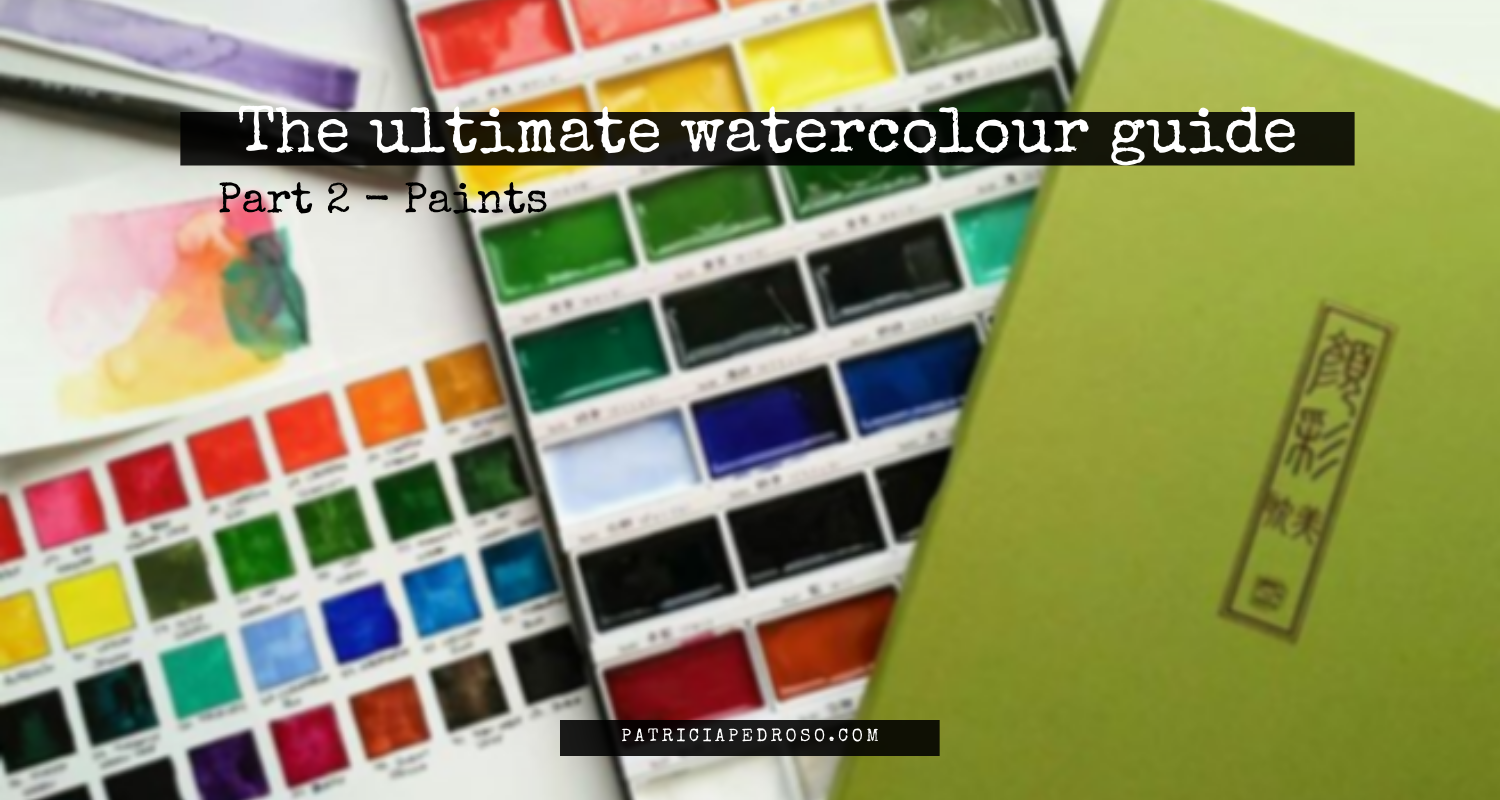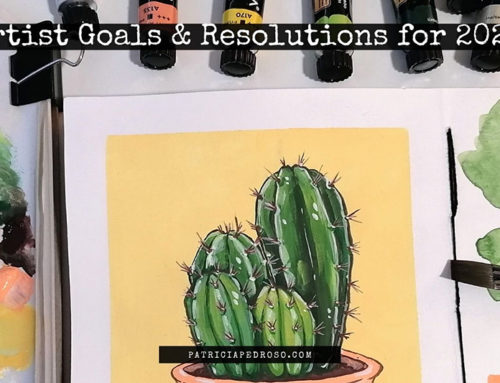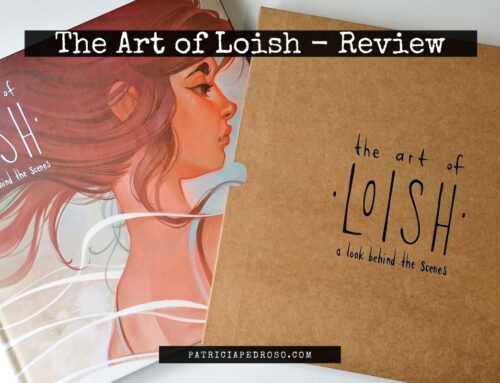Watercolour guide II: All the basics about paints
Watercolour paints can be really confusing when starting out with them, there are so many parameters to consider it can be really hard to choose!
Sometimes you might rather just pick a recommended starting pack and get on with it without overcomplicating yourself.
I know I did, at first.
If that’s your case, maybe just scroll down to the last few points of the post.
But it still might be interesting for you to learn about some of the stuff I’m saying here, you’ll need to know some of these when actually painting.
If you know a bit of what’s available out there, you might be wondering…
Tubes or pans?
Professional or student grade?
In sets or separated tubes?
Maybe buy individual tubes and fill your own empty palette?
Told ya’, too many questions!
But before answering any of these, there are a few technical aspects you should be looking for when selecting the paints.
With time, you’ll absorb all of this knowledge and you’ll have your own preferences that will influence your selections.
Let’s dive into it!
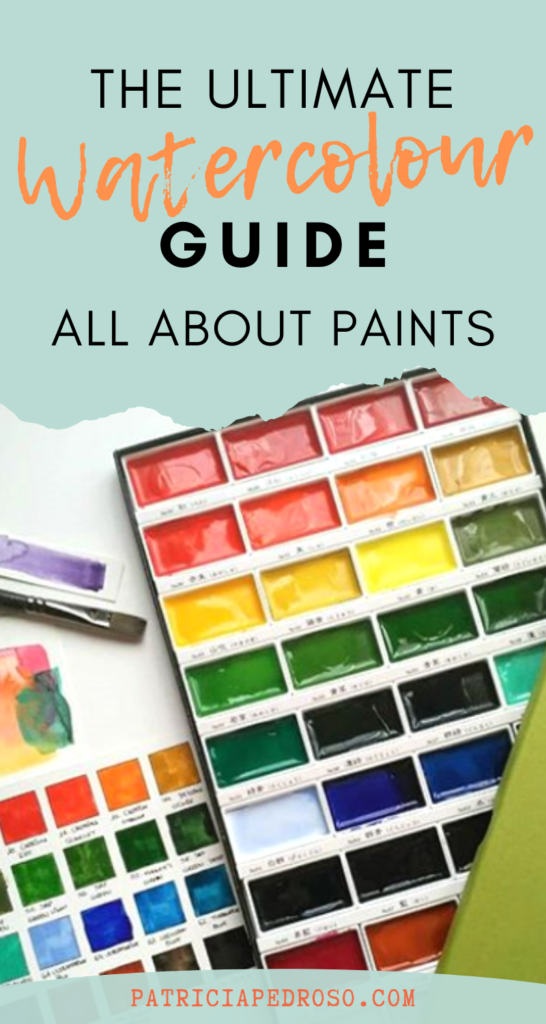

This post belongs to a bigger watercolour guide series, if you want to read more I will link the full series here: (will update it as I go for you to find them easily)
- The ultimate guide to watercolour: Introduction
- The ultimate guide to watercolour: Paints (this one)
- Watercolour Guide: Brushes & paper
- Watercolour Techniques: All you need to know
- The watercolour Guide: Extra tools to ease your process.
- 7 Exercises to practice watercolours
*Reminder that this post contains some affiliate links. This means I might get a small commission when you click and buy something with that link with no additional cost to you. However, my reviews and recommended products are not influenced by this, I’ll only recommend what I use and what I believe is good. Click here to read the disclaimer if you want more information*
INTRODUCTION TO WATERCOLOUR PAINTS: COMPOSITION
Comercial watercolours can be found in two grades: ‘Artist’ (or ‘Profesional’) and ‘Student’.
Artist quality paints are usually made using a single pigment, this results in richer colour and vibrant mixes.
On the other hand, student grade watercolour paints have less pigment and are often formulated using two – or more – less expensive pigments.
Alright, let’s talk some basics about these ‘pigments’ and the rest of the principal components of watercolour paints.
There’s four:
- Colourant, commonly pigment. Each painting is a mixture of microscopic pigment particles that serve to provide colour to the paint. These pigments don’t dissolve in water, but some brands of watercolour use dye instead, which does dissolve in water and binds the materials directly.
- The binder, this is the paint vehicle that holds the pigment in suspension, which allows it to be applied with the brush and fixes it into the painting surface when it dries.
- Additives: these are substances that alter different qualities of the paint like viscosity, hiding, durability, the colour of the pigment and the vehicle mixture. Also, they can be added to reduce the manufacturing costs of the paint too.
- Solvent: used to thin or dilute the paint for application, it evaporates with the paint when it hardens or dries.
Each paint manufacturer has its own backbone composition that’s their own recipe of these four.
It’s designed to keep manufacturing costs under control & get the best attributes for every pigment in their line.
QUALITY
So, as I said up there, there are student grade and artist grade watercolours.
But what should you choose and what’s the real difference?
The difference is usually very noticeable.
Professional or artist quality are made with more pigment and have a wider range of colour.
As the name says, they’re intended for professional artists and they’re more expensive.
Student grade paints are cheaper as they have more synthetic binders and fillers and they usually have less permanence.
How do you know which is which?
The tubes and watercolour sets will have it written on somewhere, usually is very visible.
Sometimes it can be also graded by a number or something, for example, Winsor & Newton watercolour tubes have written on it a number that equals the amount of pigment.
Series 1 is student, with less pigment, while Series 4 is professional.
When it comes to choosing you should buy accordingly to you budget.
Ideally, student grade is made for beginners & students for their cheaper price & artist grade for more experienced painters.
I will say this rule of thumb works, but it’s up to you.
Most experienced painters will say that it’s better to buy less but good quality than a huge student set.
Aka quality vs quantity.
They justify it saying that quality paints have different behaviour, so using cheap paints affects the way you learn to paint.
I always recommend for you to try out and see, I don’t really think it’s that bad to buy a cheaper set at first, besides there’s some out there that aren’t half bad!
COLOUR
When using watercolour paints most of the time you will be mixing colour, it’s rare to use pigment on its own.
And you’ll be happy to hear that’s relatively easy to get the hang of mixing them.
With this, I mean that with a little set of 5-10 colours you can basically make most of the colours you’ll ever need.
At least when you start out so you don’t make a huge investment.
(especially if buying artist grade)
There are different styles of painting, of course, while some professional artists will basically only use pigment colours – as they’re more vibrant than mixed ones – others will use a very limited palette and mix everything from there.
It’s all up to you and your painting style, really.
When it comes to colours most times white & black are left unused in watercolours, as white can be substituted with adding water and black is rarely used – as you should avoid black for mixing dark colours, basic colour mixing tip.
If you want to know more about why you should avoid black in mixtures & other colour tips here’s a blog post about it:
Some colours have different prices, that’s because of the minerals used to make the pigments, basically because some are rarer & more expensive than others.
When it comes to student grade paint, these pigments are substituted with synthetic fillers and that’s why they have standard prices, and you might see the word ‘hue’ after the pigment name on those.

PERMANENCE / LIGHTFASTNESS
This refers to the paint’s durability when exposed to light and humidity.
The level of lightfastness comes dictated by the quality of the pigments and how much filler it’s on them – if there’s any.
The effect of light/humidity on the paints will depend on the type of pigment: organic pigments will fade completely and much faster, while inorganic pigments will darken or grey – and some might even be permanent.
To check the level of lightfastness you’ll want to check the labels of your paints.
Some also come with a card/colour chart that includes this information.
For most well-known brands these charts are also online.
I think there’s different rating scales, but for example, on the ASTM (American Society for Testing and Materials) you’ll look for an I or II – excellent or good.
TRANSPARENCY
Transparency is part of the magic of watercolours but there are different grades of transparency depending on the colour.
Basically, you guessed it, this is because on the pigments used.
The smaller the particles of the pigment get the more they leave gaps for the paper to show trough.
Watercolour paints can come in opaque or transparent & this is usually written on the pans/tubes or on the charts I told you about before.
Of course, you can always thin the paints with water to make them more transparent, but you’ll need to be familiar with the level of transparency of your paints when using them.
For this, you should test them while layering then with other paints.

I found this small article with a good easy exercise to test this, you can read it here.
STAINING
Staining it’s what it sounds like, some watercolour paints can penetrate the paper, leaving a “stain”, while others will lay on the surface of the paper.
These last ones are easier to “erase” – will talk about how later on the techniques post.
This again depends on the pigment – and brands – as always with watercolour.
It will get easier and easier with practice, as you get used to all of these little variables.
When is important to know when the pigments stain or not?
When layering; a non-staining pigment can become muddy with layering, as it stays on top of the paper mixing with the rest of the colours you add after.

I always recommend making a little colour chart and practice sheet when you buy a new set or individual paints.
I used to avoid it but it has proven really useful to figure out all of these things.
It’s important you don’t only try the colours by themselves but also how they interact with others – layering and mixing.
GRANULATION
It’s an effect when painting where pigments separate from the binder, settling in the “valleys” of the paper.
So it leaves a grainy look on the paper when it dries.

While some people like this effect, some artist will avoid it like the plague, so you see, it’s all about preference again.
But there are some pigments that tend to granulate no matter what, so you might want to stay on the lookout for that.
Some brands will also include this information on their charts.
If you want more information about granulating watercolours, which pigments granulate and such to reference later you can find a really good article here.
PANS OR TUBES?
Watercolours come in two forms: paint tubes or in small dry cakes called pans.
Well, you can always make your own, but that would make for a whole different post on its own. – And I know nothing about it…
And there’s also things like water-soluble coloured pencils/markers, liquid watercolour and other pigment bars but I would hardly call that real watercolour.
In case you’re wondering, there’s really no difference in the quality of the pigment, they’re the same but in a different form.
Some artist claim tubed colours can be more vibrant than pans, but that hasn’t been proved.
The reason is probably that the concentration of paint to water will always be higher with the tube.
I’ll say, again, it’s all about preference, and also depending on the occasion, as pan sets will always be more comfortable for travelling, plein air painting etc.
Anyway, there’s definitely pros and cons to each of them, so I’m gonna list them here for you.
PANS
Pans are solid and dry and they need to be activated with water.
They are great for carrying around, as they are very practical and easy to set up: you just have to open the box and spray them a bit with water.
And also, very easy to clean up, which is always good! – even when contaminated with other colours.
If they’re relatively protected from extreme temperatures & moist they can be stored indefinitely.
Furthermore, there’s really not much waste of paint when working with pans.
They’re ideal for smaller/sketchbook paintings when larger washes aren’t required.
And now to the downsides!
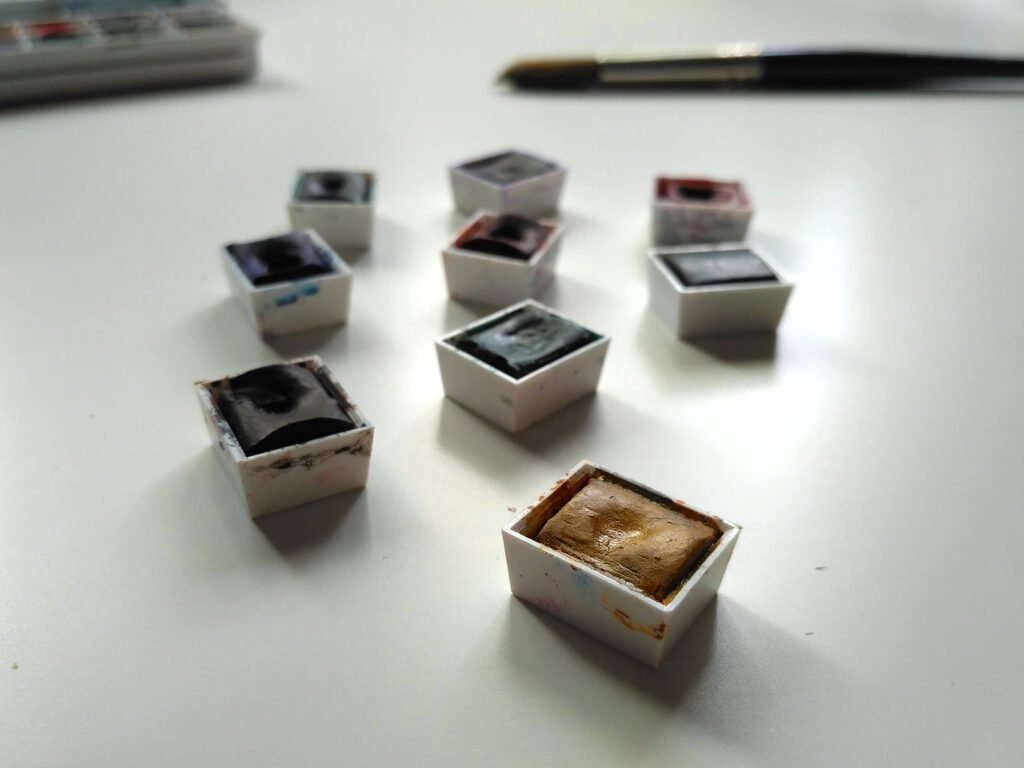
As you have to work with the brush rubbing constantly to get the pigment out of the pan, the brushes get ruined faster than with liquid paint.
Also, as they’re dry pigments they will always be harder to get saturated colours, as it takes longer to get the pigment out of the pans.
Though the intensity increases the more you moist them.
So, it basically takes more time to moisten and mix up.
Lastly, don’t be fooled by the size of the pans, as little as they might be they last a long time.
But the price for the pigment they contain is quite expensive in comparison to tubes. – two or three times the tube price.
TUBES
The tubes on the other side are filled with liquid paint, so it’s more fluid but there’s more viscosity to them.
Your brushes will last longer but the paint might not, as you will use more of it while painting.
You can always fill empty pans with them and the paint will last longer that way. But be careful when doing this, some brands don’t hold up well this way, they will dry out.
Tubes can be a bit messier to deal with – especially for travelling/plain air painting – but they’re way more efficient when mixing large quantities of paint.
With tubes it’s harder to judge the quantity of paint you need for a painting, so you’ll end with excess paint on your palette that will -eventually – dry out.
Usually, you waste more paint than with pans.
Tubes can also get contaminated with other colours and be really difficult to retrieve.
They’re also the inconveniences that come with tubes: the paint around the cap dries out and it gets difficult to open with time, it’s bulky and it can dry out or burst.
RECOMENDATIONS
Further along in the series I’m gonna make a detailed post about how to choose your watercolours with more tips for you to choose better or in case you want to set your own palette.
If you want to get notified when a blog post is out, you can sign up to my mailing list, it also comes with some freebies!
But just in case you’re impatient to get your own I will leave here a good list of sets you can get that are pretty good and recommended around.
I want to say, I haven’t tried all of them – I will mention it in the ones I’ve tried – but these are all well known and I’ve heard them recommended more than once, cause I want to give you more options.
There’s ton’s of reviews online of watercolour sets, for example, I will recommend checking out Tori’s channel Juicy Ink (video below) or her new one Victoria Gedvillas, cause she’s a really skilled watercolourist and tests tons of sets on her videos.
& her watercolour colecction is just goals 😍🙌
Now, on to the recommended sets, there’s some for begginers & some for more pros:
I’ll start with the ones I have.
BEST WATERCOLOUR SETS FOR BEGINNERS
Winsor & Newton Cotman compact set:

Okay, this one I do have and it’s widely known and recommended between artists starting.
I have changed some of the pans for some I bought separately, for example, taking out the white.
This one is from Winsor & Newton student’s line, the packaging is really practical as a travel set, as it fits everywhere and comes with 12 half pans and a little brush – I don’t like the brush much though.
It’s very affordable for the quality it has, but it’s still student grade.
Some artists really love it but for me, it has never really hit the spot. The colours, for example, seem way less saturated than the Van Gogh student’s set that was the first one I bought and I still like a bit more. – I’ll talk about it below.
But I must admit this set it’s so tiny that has been really practical when traveling!
Van Gogh Pocket box or tubes:
I have this one (comes with 12 pans) but the one I link up there is a new version with 3 extra free pans, that I think it’s a better deal.
I used this one so much at the beginning and I loved it, it comes with a separated mixing palette that you can use inside the box o take it out, and the brush that comes inside wasn’t that bad – it’s bigger than the W&N one and a bit more practical.
The set’s also a bit bigger than the W&N but I think it makes it a bit more comfortable, especially cause there’s more space for mixing.
Is still student grade and I haven’t used it in a bit but I still think it was really good to start out. The quality always seemed good enough for me!
There’s also a version in tubes, that I’ve heard good things off too, in case you rather try it that way:
Kuretake Gansai Tambi
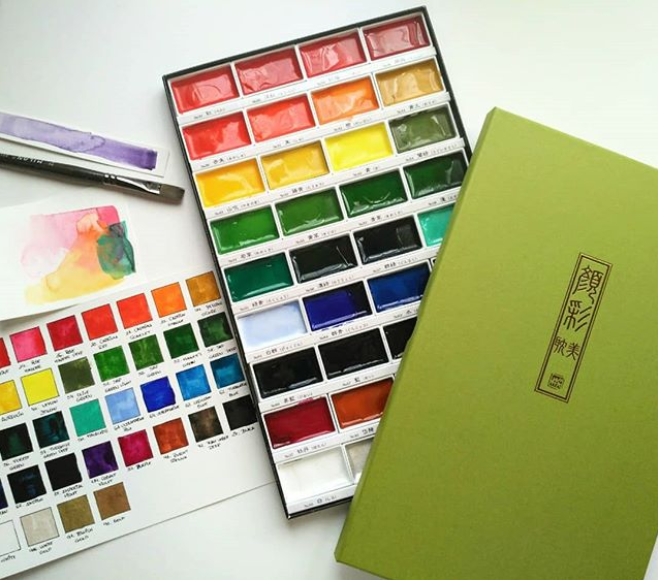
What can I say about this watercolours, they’re simply gorgeous, the colours are incredibly saturated and the pans are very big.
When an art supply is lovely and it inspires you to paint whenever you open them I just thing they’re perfect.
I don’t put them in “sets for professionals” because I don’t really know their supposed quality.
I’ve seen plenty of professionals use them and say they like them, especially because of the vibrancy of the colours.
But, in case you want to know more, here’s my unboxing/first impressions video:
Now, on to some other recommendations!
(keep in mind I haven’t tried them, but there all well known)
BEST WATERCOLOUR SETS FOR PROFESSIONALS
Of these, I haven’t tried any.
But I’m looking forward to getting a set of one of these, I’ve heard good things about them all!
- First row:
Paul Rubens professional watercolour paint and Winsor & Newton professional 24 half pans
- Second row:
M.Graham basic 5 set of professional watercolours & Mijello Mission Gold Palette Set 36 Colors
Third row: Schmincke Horadam Aquarell 24 pans & Senellier French metal set
That’s all on watercolour paints for today’s post!
Wow, that was a long one to write and research…
You can go ahead now and read the next one on brushes & paper!
And don’t hesitate on leaving your own recommendations or advice about watercolour paints in the comments.

